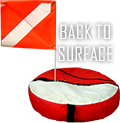On Target by Bob Libbey
One great thing about bottle hunting is that you can find almost anything. You can also find nothing. That’s part of the fun. It’s a treasure hunt and you never know what might turn up. Sometimes you find the type of items you’d expect to find. At other times, you find something totally different…
When we first started diving, we were simply exploring the underwater environment. The antique bottles that we initially found stumped and intrigued us. We quickly learned more about them and began to collect them. Along the way, we found a whole bunch of stuff. We’ve found just about anything you could lose or discard. We’ve dragged in boats, lures, wind-sails, anchors and fishing poles. All would predictably be recovered from the water. Other items are more obscure. We’ve found toilets, automobiles, pots and pans, fire extinguishers, bugles, ice cream signs, and lawn furniture. We’ve even found the kitchen sink. (Well, maybe just a kitchen sink).
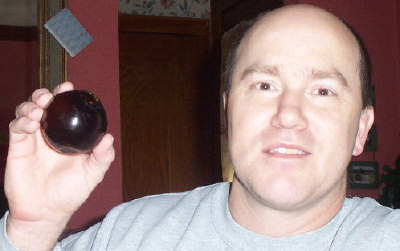 One thing I would have never expected to find was a target ball. In fact, I never even heard of a target ball before I became a glass collector. Before skeet shooting, before clay pigeons were ever dreamed of; target shooting had already begun. One would think that people would practice by firing at (God forbid) bottles, tins, trees and the lake. However, there were also moving targets; glass target balls. The targets must have been used by an elite crowd. They were probably fairly expensive. The glass was typically hand-made by a glassblower blowing hot molten glass into a mold. Some targets were made in extraordinary colors and look like fine crystal. Others were plain. Some molds had patterns with manufacturing information and exquisite detail. In short, the target balls were beautiful pieces of artistic glass that have since become historic relics. The problem is, they were created to be destroyed.
One thing I would have never expected to find was a target ball. In fact, I never even heard of a target ball before I became a glass collector. Before skeet shooting, before clay pigeons were ever dreamed of; target shooting had already begun. One would think that people would practice by firing at (God forbid) bottles, tins, trees and the lake. However, there were also moving targets; glass target balls. The targets must have been used by an elite crowd. They were probably fairly expensive. The glass was typically hand-made by a glassblower blowing hot molten glass into a mold. Some targets were made in extraordinary colors and look like fine crystal. Others were plain. Some molds had patterns with manufacturing information and exquisite detail. In short, the target balls were beautiful pieces of artistic glass that have since become historic relics. The problem is, they were created to be destroyed.
Think of the life-span of these glass targets. As mentioned, they were blown into a mold. Then they had to be removed and cooled. Sometimes they were filled with feathers or the like to create a spectacular effect mid-air when they were hit. Next, they were packaged for sale and transported over rough nineteenth century roads by horse and carriage, or by railways (or both). Ultimately, they were put to use as targets. They were loaded in a catapult or otherwise launched as high as possible into the air. Then, they were fired at by live ammunition. Assuming that they survived all of this intact, they fell to the unyielding ground and smashed. You would think that the only known remaining examples would be unused targets.
However, there is the water factor. If someone was launching the targets over the water, and took a bad shot, there is a chance that the targets could survive the landing. Then, it may be a race to sink. You’d think that a target floating on the surface would remind the target shooter of their shooting prowess. This taunting may be cause for a second, more-properly-aimed, shot.
Assuming the target sank to the bottom, in order to find it whole, it would still have to avoid hitting any hard objects or stones. It would need to survive any current or water flow. Additionally, it would face Wisconsin winters with yearly freeze-thaw cycles (for over a hundred years!). It would need to avoid anchors that were thrown overboard by boaters. Those anchors can dredge a path along the bottom as boats above are blown about by the wind. After all that, there is just the small matter of finding it hidden among the muck, rocks, debris and sediment somewhere on the bottom of a lake or river. As noted, I would have never expected to find one. That is, unless someone else just had…
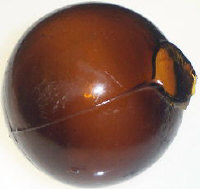 Mrbottles and I had taken a newly dive-certified bottle-collecting buddy (Gary) out with us diving. We were hoping not only to help Gary get his first underwater finds, but also to bring home some treasure ourselves. We planned a three-tank day. Our first tank was in a spot that had produced some great bottles. They were in an old area but hidden in thick, heavy, tall weeds. Mrbottles conjectured that the weeds may have always grown there. Therefore, they would deter other divers from thoroughly searching the area. It turned out that he was correct. However, by the time we took Gary to this spot, we’d worked it over pretty hard. That first tank, we came away with very few finds. I don’t think that Gary found anything. We decided to try a different spot for our second tank where Gary would be sure to find at least something. As I was finishing up that second tank, a little tired from all the searching, Mrbottles let me know that he had just found a target ball. He was encouraging me to go over exactly where he found it to search for more. My tank had only a few minutes of air left, and I thought I was on the verge of finding something good, so I stayed put. When I returned to the boat, I got to see and hold that crude amber sphere. I definitely wanted to get in and look for more now that I knew they were here. Mrbottles thought that I wasn’t very interested in target balls because I didn’t rush right over to where he found them at the end of the last tank. He was ready to go home. I told him that, if he wanted, he could quit and wait in the boat, but I was going back in! After all, how many chances do you get to find target balls? I strapped on a new tank and hit the water. I think Mrbottles came out with me but Gary waited in the boat. I swam over about twenty-five feet from where Mrbottles indicated he had just found the target ball. I figured that I would be in the same general landing zone. Within just a few minutes on the bottom, I came upon a round object. That’s it, I found it! I brought it to the surface in anticipation of a gorgeous target ball. It was an old wooden croquet ball with no paint on it saturated with water. I couldn’t do anything but wonder what the odds were that I’d find a wooden ball right then. I submerged again. A few minutes later, I felt what seemed like a perfect sphere. I didn’t want to be tricked again, so I felt it for a few moments. This time, it seemed really hard and smooth. It was like a fist-sized hardball. I brought it up and it was a target ball. I found one!
Mrbottles and I had taken a newly dive-certified bottle-collecting buddy (Gary) out with us diving. We were hoping not only to help Gary get his first underwater finds, but also to bring home some treasure ourselves. We planned a three-tank day. Our first tank was in a spot that had produced some great bottles. They were in an old area but hidden in thick, heavy, tall weeds. Mrbottles conjectured that the weeds may have always grown there. Therefore, they would deter other divers from thoroughly searching the area. It turned out that he was correct. However, by the time we took Gary to this spot, we’d worked it over pretty hard. That first tank, we came away with very few finds. I don’t think that Gary found anything. We decided to try a different spot for our second tank where Gary would be sure to find at least something. As I was finishing up that second tank, a little tired from all the searching, Mrbottles let me know that he had just found a target ball. He was encouraging me to go over exactly where he found it to search for more. My tank had only a few minutes of air left, and I thought I was on the verge of finding something good, so I stayed put. When I returned to the boat, I got to see and hold that crude amber sphere. I definitely wanted to get in and look for more now that I knew they were here. Mrbottles thought that I wasn’t very interested in target balls because I didn’t rush right over to where he found them at the end of the last tank. He was ready to go home. I told him that, if he wanted, he could quit and wait in the boat, but I was going back in! After all, how many chances do you get to find target balls? I strapped on a new tank and hit the water. I think Mrbottles came out with me but Gary waited in the boat. I swam over about twenty-five feet from where Mrbottles indicated he had just found the target ball. I figured that I would be in the same general landing zone. Within just a few minutes on the bottom, I came upon a round object. That’s it, I found it! I brought it to the surface in anticipation of a gorgeous target ball. It was an old wooden croquet ball with no paint on it saturated with water. I couldn’t do anything but wonder what the odds were that I’d find a wooden ball right then. I submerged again. A few minutes later, I felt what seemed like a perfect sphere. I didn’t want to be tricked again, so I felt it for a few moments. This time, it seemed really hard and smooth. It was like a fist-sized hardball. I brought it up and it was a target ball. I found one!
The condition was really remarkable. Outside of some inside mineral deposit, it was perfect. It has seams coming down each side from the top meeting a molded ring in the center. I take that to be a three-part mold. The neck is tiny with a very crude sheared mouth. You can imagine the glass blower stretching the molten glass to tear the target off of the blowing rod. The glass itself is crude, thin and uneven. In short, it is beautiful! It is also simply amazing that something seemingly so fragile and delicate could be found in such great condition.
We returned to the spot on other days to search for more. Mrbottles dove without gloves (at some risk to his fingers) to enhance his sense of touch. He only came back with a few broken shards, though. We never found another whole one.
This story shows no particular skill or extraordinary effort on my part. I was simply doing the right thing, in the right place, at the right time. It was the place Mrbottles just sent me to. Nonetheless, I still consider myself lucky to have found a target ball. Thanks again are in order to Mrbottles. Thank you for the spot. Oh, and one last bit of thanks to the gentleman or lady who was out shooting a long, long, long time ago. By missing their mark, they allowed Mrbottles and myself to be right on target!
